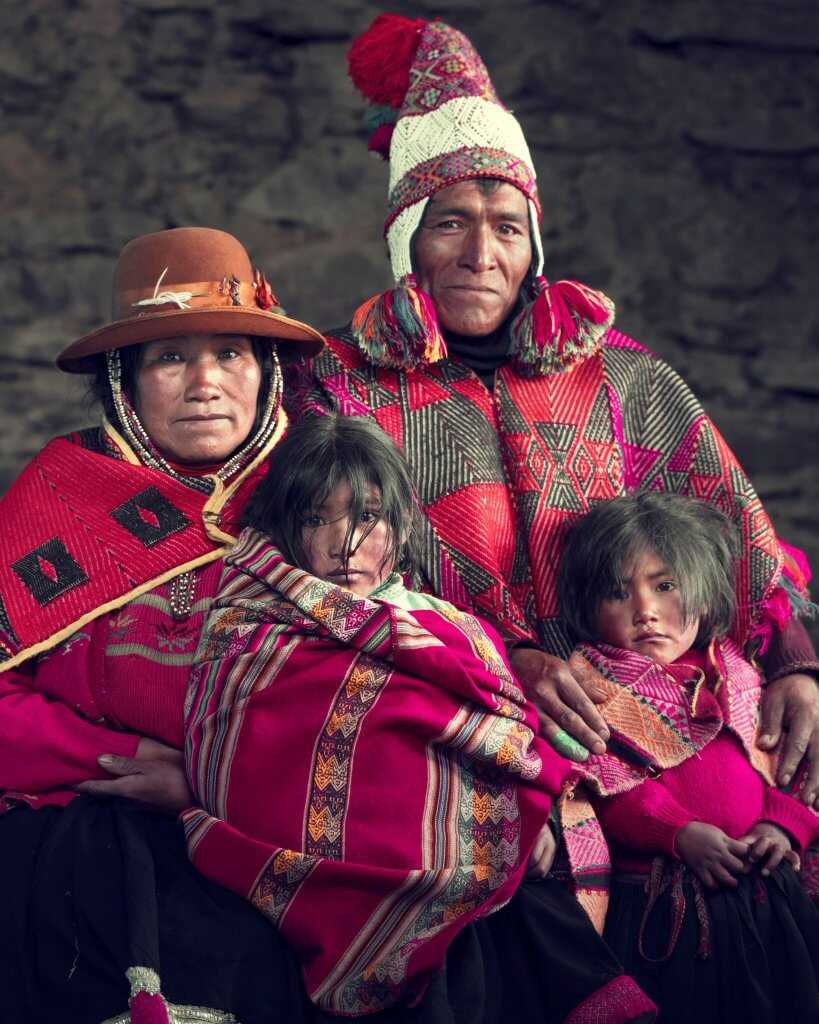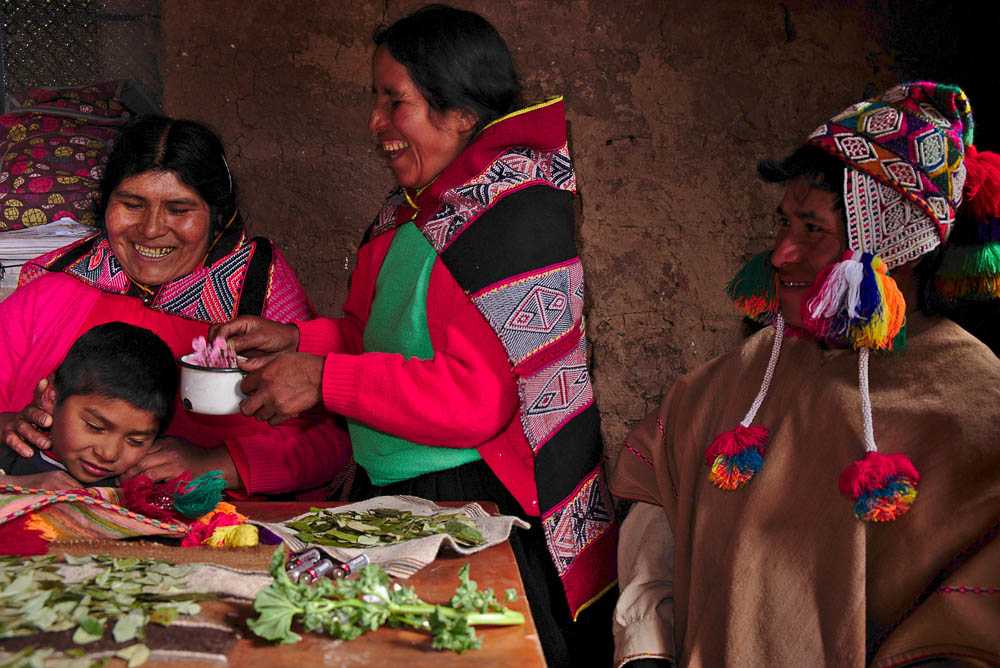The community of Q'eros is the descendant of the Incas, this is one of the communities that has persevered over the years. Get to know the Q'eros community through this post.
The community of Q'eros is a quechua community located in the province of Paucartambo in the department of Cusco. It is a village that dates back to the ancient peoples of Tahuantinsuyo. Their descendants are located in the jungle at the edge of the Ausangate mountain, at an altitude of 4400 meters above sea level. This community is known as the last Inca community in the country, for its characteristics of life, culture, and clothing that they have maintained since the Incas.
The Q'eros community as a people was declared as cultural heritage of the Peruvian nation on November 21, 2007, this declaration mentions that the Q'eros community has preserved its identity through time contributing to the cultural heritage of Peru.
The Q'eros are known as the wisdom keepers of the Andes. Considered the "Last Inca Ayllu", or the last Inca community in Peru, the Q'eros strive to preserve and promote their indigenous cultural and ethnic identity.
They live a life of work and are one with nature: offerings are made to Pacha Mama (Mother Earth), and to the Apus, (mountain spirits) in exchange for the well-being of their animals, crops and themselves. The worldview of the world concept of Ayni (reciprocity), the importance of reciprocal exchange, and animu, the awareness of an animate essence in all things, shape their interactions with each other and with their environment.
Love, joy, perseverance, intrinsic integrity, and the ability to "just be" permeate their daily lives with all that nature has to offer. The Q'eros travel between three different ecosystems ranging from 4,400 m.a.s.l. to 1,800 m.a.s.l. from the snow-capped peaks to the jungle brow. They herd llamas and alpacas at the highest altitudes; descend to grow potatoes and raise sheep; and descend further to grow corn, squash and other vegetables, and to harvest bamboo and wood for their constructions and also for making their looms and flutes.
Despite the harsh conditions to which they are exposed, and a history of discrimination and marginalization, the Q'eros endure.

The culture of the Q'eros is very ancestral and is based on some myths that communicate the respect and solidarity between man and Pachamama, that is, our mother earth. The Q'eros, have a different way of relating to their surroundings, in which, without a doubt, they place in a central point the spiritual side. The Quero culture is important not only for Peru, but for all humanity, where they are currently living in alert due to the threat of mining exploitation of their soils and the cultivation of coca leaves, which is considered illegal.
For the Quero community, there is no distinction between the physical and the spiritual, they conceive everything as sacred, because everything is part of Kausay Pacha, the universe as living energy. They perceive the cosmos as a form of living energy that palpitates and feels. Everything that exists is part of the same essence, where man and nature are integrated. The philosophy of the Inca Queros is not different from other cultures, both Eastern and Christian, about a living energy that sustains the universe and the relationship of man with this energy.
The Pachamama, or mother earth, is also considered a living energy that permeates the entire universe. The cosmovision of Andean cultures such as the Queros admits that the reason for life and its objective is Wiñay (evolution), which is integral and exists in all planes of existence. The Queros of Peru also believe that every human being has the potential to grow spiritually, since we are carriers of Inka Muju (Inca seed), and become Sapa Inka.
This Andean community bases its tradition on the ancient way of seeing the cosmos as a living form of vital energy, which is available to man, it is another way of seeing the divine potential that every human being has.
In the Quero culture they do not prepare shamans but Paqos. Paqos means to be heir of the tradition, it is a preparation that is usually chosen, since it is chosen because one wants to grow spiritually. It is not imposed. The main function of a Paqo is to prepare himself to grow spiritually and acquire Samy (fine energy), and thus possess the wisdom to develop his levels of consciousness.

Myths of the Queros
The Queros are made up of approximately 2,500 community members, who carry out agricultural work divided into the cultivation of corn, potatoes and the raising of llamas and alpacas. This native people, maintains its traditions intact, both in social organization, religion and production system, as in pre-Hispanic times or Inca times. Following their "discovery" in the 1960s by anthropologist Oscar Núñez del Prado, the Queros Andean communities opened up to the modern world, their ideology and philosophy of life. However, this gave rise to exaggerations and myths of these Quechua natives.
The myths of the Queros are quite famous in the Andean communities. Many of them were compiled in 1955 by Oscar Núñez del Prado. Among them the most famous myth of Inkarri. This nation is one of the oldest peoples of the Tawantisuyo or Inca Empire, who live in the Antisuyo region. The openness of the Qeros communities in this globalized world has allowed others to know the essence of the Andean ideology and paradigm.
On the other hand, this has also provoked many exaggerations and modern myths about the life of this community.
They live close to the clouds
It has been unfoundedly said that the Queros live at more than 5,000 meters above sea level. Today it is known that they inhabit 3 ecological levels ranging from 1500 to 4500 meters above sea level. Some spiritual and mystical circles can be heard saying that the Q'ero live only above "5 thousand meters". According to these circles this is to protect themselves from the curious and from modern culture. The truth is that the Q'ero form a macro Ayllu. It moves and occupies three ecological levels.
From 1500 meters above sea level with access to the high jungle or the mountain, to the highlands of 4500 meters above sea level. Each level has its own economy and lives in symbiosis with the others.
They lived in the heights for 500 years
Although the Quero territory seems inaccessible, the Inca road network was efficient for transit and communication with the outside world. For reasons of barter, trade, festivities and sociability.
They are the last Incas
It is probable, but there are other populations and cultures that maintain similar ideologies, customs and traditions similar to the pre-Hispanic. It is possible that they maintain their DNA unaltered, however, as a result of the Hispanic occupation, there was constant miscegenation, which makes it difficult to find purebred peoples.
The legacy of the Quero is of utmost importance for humanity. Today they are threatened by the mining exploitation of their land and the illegal cultivation of coca by drug traffickers. The Quero culture goes hand in hand with spirituality, because their daily life and their vision of life are always linked to spiritual development.
Their folklore, music, dances and festivities, their oral traditions, as well as their production system and way of life. They are part of the holistic vision of this Andean people, who conceive everything through spirituality and the development of the state of consciousness. The Q'eros should be understood in all their vital aspects, as mystical individuals, who develop their lives through spirituality and are part of a great culture.
Therefore, it is advisable to know more about them, to visit them, to be filled with those visions that, although they are different from ours, enrich us more and more every day.
Spirituality is certainly an integral part of the Q'ero's life, however, they give equal importance to productive, social life and festivities. The Q'ero are dedicated to Shamanism only. With the Q'ero, ancestral knowledge has been greatly nourished, this cannot be denied and we have to be grateful for this contribution to spirituality and the soul by the Q'ero shamans.
Normally people mistakenly think that the Q'ero are a kind of shaman masters who dedicate themselves only to the reading of the coca leaf and to celebrate the offerings with the Pachamama. Actually, the Q'ero are much more than just precepts, this nation has a rich folklore, which is nuanced by their clothing, customs, music and dance. For the Q'ero, the spiritual part is necessarily linked to the lifestyle of the Andean people, so other important aspects such as productive life, social organization or local festivals should not be neglected.
Tourism activity in the Quero region has increased in recent years, which benefits the inhabitants economically. The Q'ero only seek to promote spiritual tourism. Lately, the Q'eros have become part of the mystical tourism routes and this really has a very positive side, because, obviously, it allows to grab economic resources from tourists that come from abroad and that benefit the Q'ero.
 Consult an expert
Consult an expert
 Chat
Chat